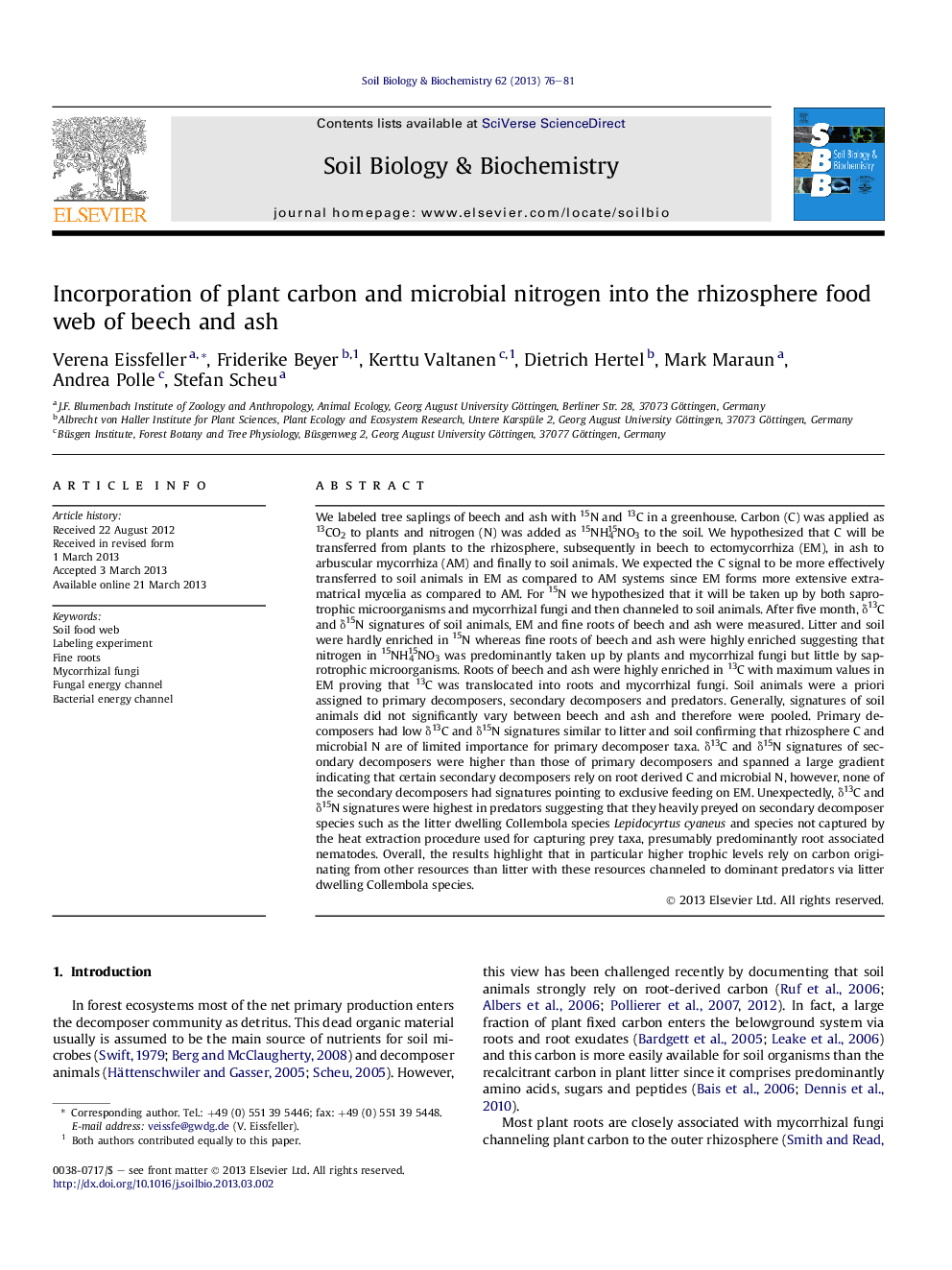| کد مقاله | کد نشریه | سال انتشار | مقاله انگلیسی | نسخه تمام متن |
|---|---|---|---|---|
| 8365242 | 1542622 | 2013 | 6 صفحه PDF | دانلود رایگان |
عنوان انگلیسی مقاله ISI
Incorporation of plant carbon and microbial nitrogen into the rhizosphere food web of beech and ash
ترجمه فارسی عنوان
ترکیب کربن گیاهی و نیتروژن میکروبی به داخل غذای ریزوسفر راش و خاکستر
دانلود مقاله + سفارش ترجمه
دانلود مقاله ISI انگلیسی
رایگان برای ایرانیان
کلمات کلیدی
وب سایت مواد غذایی خاکی، آزمایش برچسب گذاری، ریشه های زیبا قارچ میکوریزا، کانال انرژی قارچ، کانال انرژی باکتریایی،
موضوعات مرتبط
علوم زیستی و بیوفناوری
علوم کشاورزی و بیولوژیک
دانش خاک شناسی
چکیده انگلیسی
We labeled tree saplings of beech and ash with 15N and 13C in a greenhouse. Carbon (C) was applied as 13CO2 to plants and nitrogen (N) was added as 15NH415NO3 to the soil. We hypothesized that C will be transferred from plants to the rhizosphere, subsequently in beech to ectomycorrhiza (EM), in ash to arbuscular mycorrhiza (AM) and finally to soil animals. We expected the C signal to be more effectively transferred to soil animals in EM as compared to AM systems since EM forms more extensive extramatrical mycelia as compared to AM. For 15N we hypothesized that it will be taken up by both saprotrophic microorganisms and mycorrhizal fungi and then channeled to soil animals. After five month, δ13C and δ15N signatures of soil animals, EM and fine roots of beech and ash were measured. Litter and soil were hardly enriched in 15N whereas fine roots of beech and ash were highly enriched suggesting that nitrogen in 15NH415NO3 was predominantly taken up by plants and mycorrhizal fungi but little by saprotrophic microorganisms. Roots of beech and ash were highly enriched in 13C with maximum values in EM proving that 13C was translocated into roots and mycorrhizal fungi. Soil animals were a priori assigned to primary decomposers, secondary decomposers and predators. Generally, signatures of soil animals did not significantly vary between beech and ash and therefore were pooled. Primary decomposers had low δ13C and δ15N signatures similar to litter and soil confirming that rhizosphere C and microbial N are of limited importance for primary decomposer taxa. δ13C and δ15N signatures of secondary decomposers were higher than those of primary decomposers and spanned a large gradient indicating that certain secondary decomposers rely on root derived C and microbial N, however, none of the secondary decomposers had signatures pointing to exclusive feeding on EM. Unexpectedly, δ13C and δ15N signatures were highest in predators suggesting that they heavily preyed on secondary decomposer species such as the litter dwelling Collembola species Lepidocyrtus cyaneus and species not captured by the heat extraction procedure used for capturing prey taxa, presumably predominantly root associated nematodes. Overall, the results highlight that in particular higher trophic levels rely on carbon originating from other resources than litter with these resources channeled to dominant predators via litter dwelling Collembola species.
ناشر
Database: Elsevier - ScienceDirect (ساینس دایرکت)
Journal: Soil Biology and Biochemistry - Volume 62, July 2013, Pages 76-81
Journal: Soil Biology and Biochemistry - Volume 62, July 2013, Pages 76-81
نویسندگان
Verena Eissfeller, Friderike Beyer, Kerttu Valtanen, Dietrich Hertel, Mark Maraun, Andrea Polle, Stefan Scheu,
